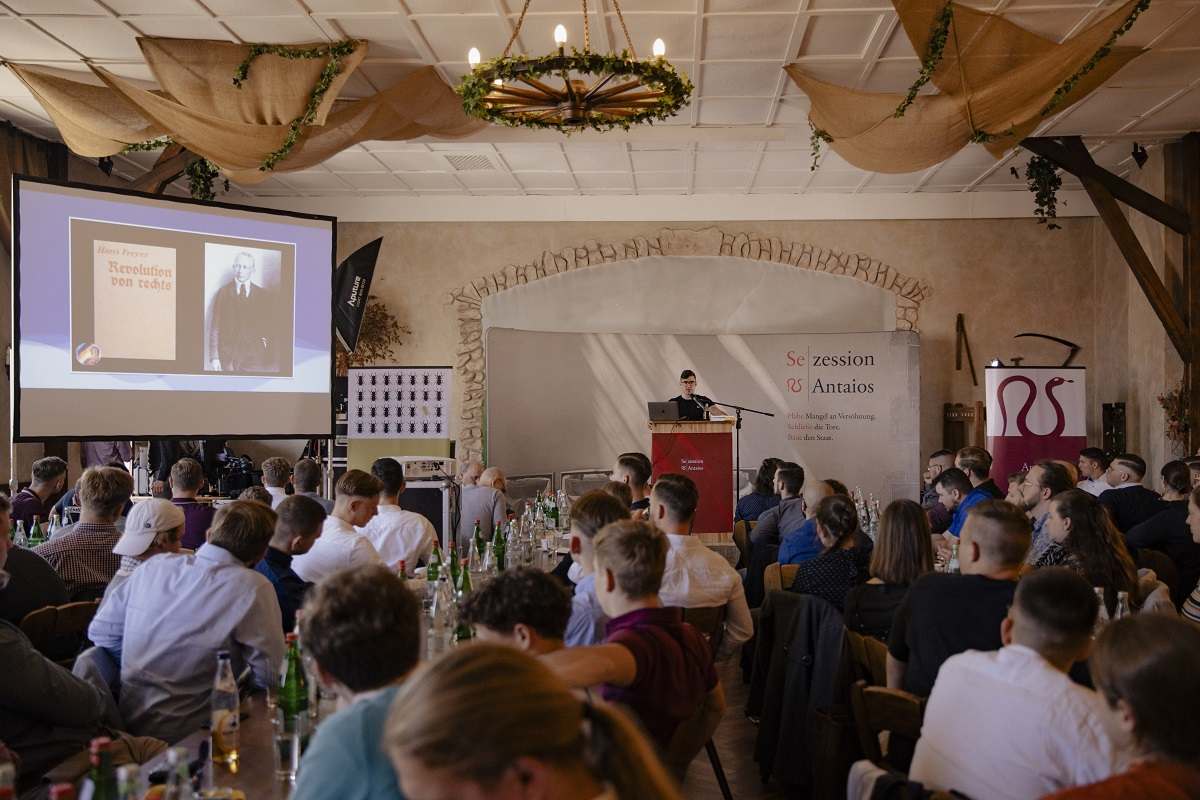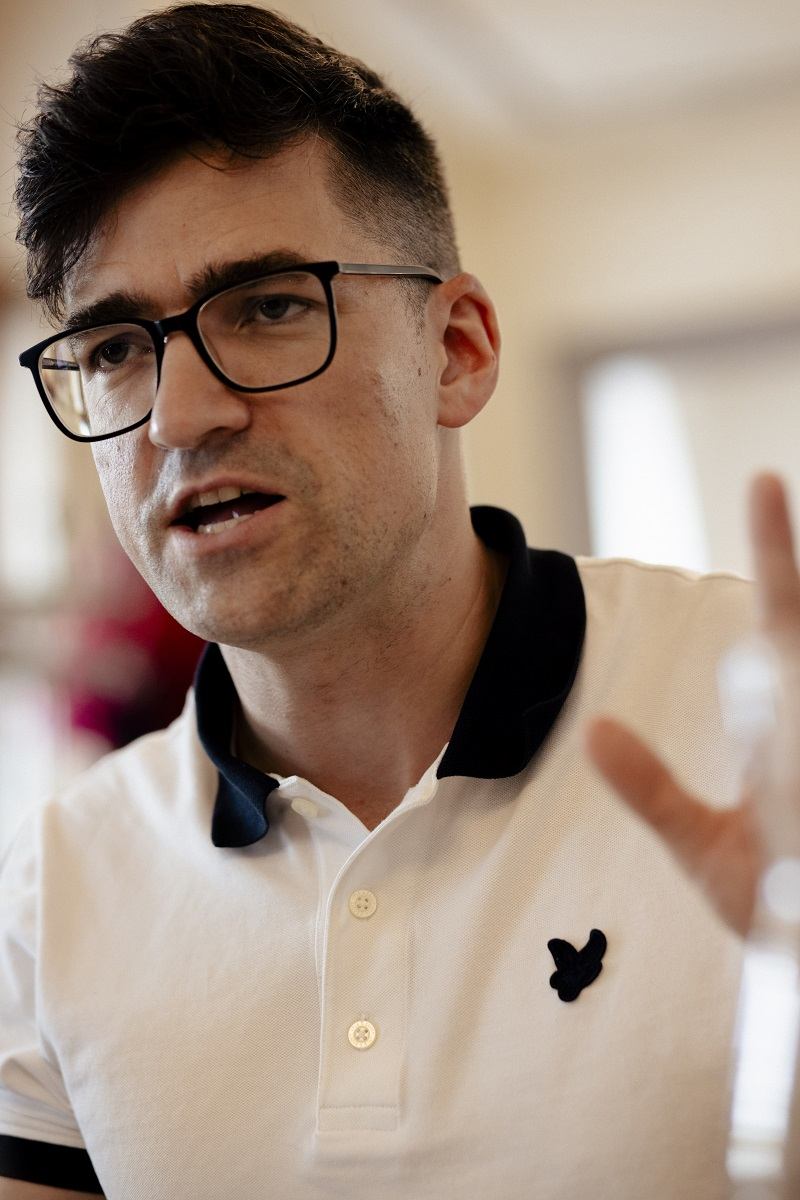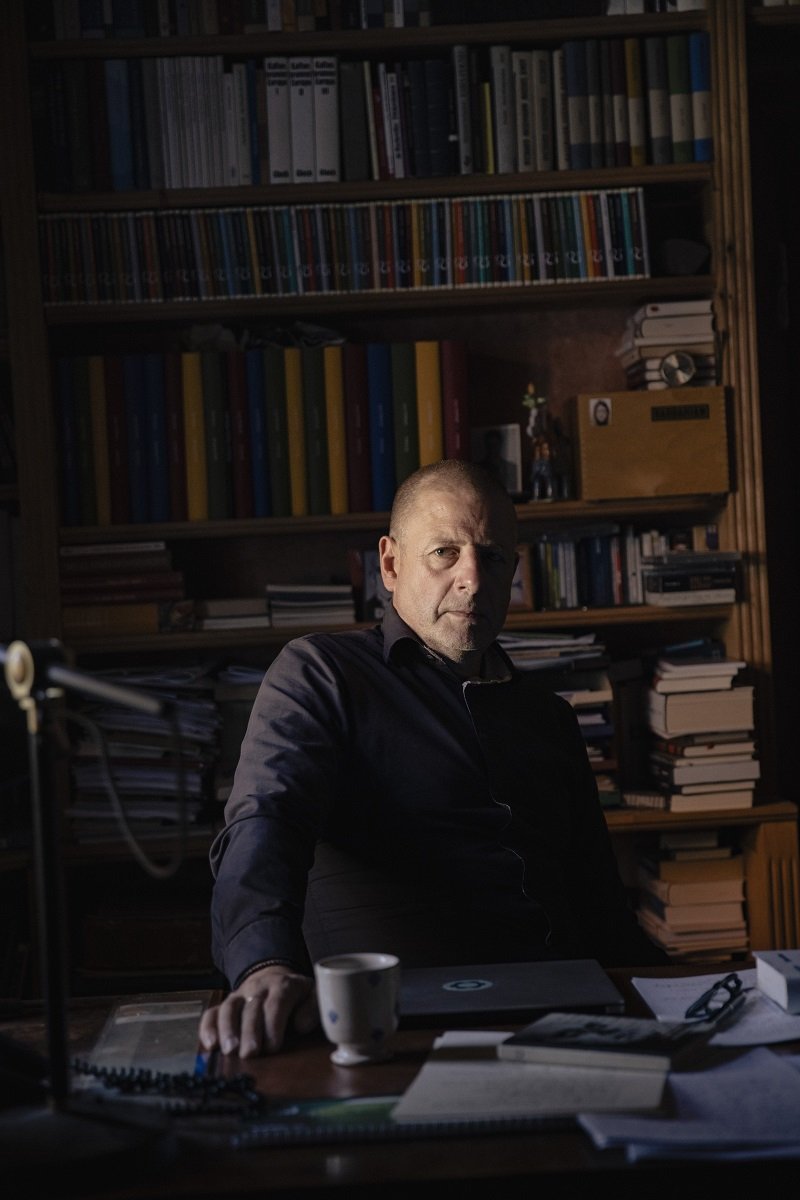
Sellner addresses far-right activists, politicians and writers at a summit in Schnellroda.
16:10 JST, September 30, 2024
SCHNELLRODA, Germany – In a food hall adorned with pastoral scenes of rural German life, Martin Sellner, self-proclaimed champion of mass migrant deportations, fielded question from a rapt audience. An ash-blond young mother raised her hand. She remarked on the importance of improving Germanic gene pools, then asked whether a people of such “progress and innovation” should honestly see themselves as run-of-the-mill humans.
“Good question,” Sellner said, responding with an answer that touched on biology, population trends and extraterrestrial invasions.
When asked directly, Sellner, 35, a far-right Austrian provocateur, will say he is no racist – but argues that each race would be happier in its own geographic corner. His Generation Identity movement, he says, adheres to nonviolent activism to protect ethno-European culture, citing Mohandas K. Gandhi and the Arab Spring as inspiration.
European intelligence officials, however, call him “dangerous” – the leading figure of a right-wing extremist group that they say is radicalizing a generation of White and angry Europeans.
With studious glasses, philosophical references and the vibe of an intellectual, Sellner has become a major force in normalizing words and concepts considered unsayable only a few years ago.
“When it began, right-wing activism in Europe was something of a skinhead line, and [Sellner] made it fashionable, like Greenpeace,” said Maximilian Krah, a member of the European Parliament from the far-right Alternative for Germany (AfD) party.
Analysts assess that Sellner has been particularly effective in cultivating young activists. But the ideas he propagates are also finding a home with established political parties on both sides of the Atlantic.
Austria’s far-right Freedom Party could win an election Sunday on a platform that incorporates Sellner’s rhetoric. And when The Washington Post spent time with Sellner this month, he excitedly described his latest “vindication”: former president Donald Trump’s mention of “remigration,” Sellner’s pet project, as part of a plan to “end the migrant invasion of America.”
Sellner told The Post: “I always thought that this would be a meta political victory to make this term known, and against many odds, we really made it international.”
As popularized by the multilingual Sellner, “remigration” envisions the systematic expulsion of millions of undocumented immigrants. He has his sights on Austrian citizens with foreign heritage, too. He contends that those who insist on living within separate communities should face “economic” and “cultural” pressure to “either assimilate or remigrate.”
Various governments have tried to constrain Sellner’s influence. Britain has barred him from entry, and Switzerland kicked him out. He says the United States canceled his travel permit in 2019, ahead of his wedding to American alt-right influencer Brittany Pettibone. German authorities this year sought to ban him – a ruling Sellner challenged in court and won.
Sellner has also been banned from YouTube, Instagram, TikTok and Facebook. Eighty-seven financial institutions in multiple countries have blacklisted him or closed his accounts. In Austria, displaying the shieldlike symbol of his movement in public is now punishable by law.
Yet despite, or maybe because of, the attempts to silence him and limit his movements, his reach and notoriety have continued to grow.
The Post spent three days with Sellner to understand his secretive Generation Identity movement. He gave us a rare look at the group’s esoteric “cellar” in Vienna, where its members hold boxing matches, make banners and give speeches. We then traveled with him to the far-right Summer Academy youth summit in eastern Germany, where the fit White men in attendance sported the close undercut and form-fitting black and white shirts favored by Identitarians.
What emerged is a portrait of a charismatic pied piper who expounds far-right thought with disarming charm. We observed him offering a sense of direction and purpose to young Germans and Austrians. Shed your guilt, he tells them, and embrace patriotism and pride – concepts that in his worldview support mass expulsions and ethnic separation echoing the darkest chapter of European history.
“The project of un-diversifying … societies is a project of violence of epic proportions,” said Bernhard Weidinger, a Vienna-based expert on the far right. “Sellner can say that it’s not, but that’s still the only conceivable way this can ever go down.”
***

Sellner speaks with Washington Post journalists at Café Weimar in Vienna.
In Germany and, to a lesser extent, Austria, the horror of Adolf Hitler’s war produced a societal firewall – a consensus that the far right should never again gain political power or intellectual purchase. But brick by brick, that wall is crumbling, with the help of Martin Sellner.
Earlier this year, his latest book – promoting remigration – became a bestseller on German-language Amazon. The concept has its intellectual origins in France, but analysts and the Identitarians themselves see Sellner’s advocacy as key to its spread.
Following revelations in January that Sellner discussed remigration during a secret meeting with members of Germany’s AfD, tens of thousands of protesters took to the streets of German cities for days, suggesting both the extent of his enduring toxicity and the measure of his power. Despite those protests, the AfD in Thuringia – which campaigned on a slogan of “summer, sun, remigration” – this month became the first far-right party since World War II to win a German state election.
Austria’s Freedom Party, which once saw the Identitarians as too extreme, now compares Sellner’s movement to nonprofits like Greenpeace while suggesting it has been wrongly labeled as extremist. “If the Identitarians are championing a political project or initiative that we think is acceptable, then why should I not support it?” Herbert Kickl, the party’s leader, told Austrian national broadcaster ORF last year.
The Freedom Party has formed part of Austrian governments before, but as a junior partner. If it emerges victorious on Sunday, it could still struggle to form a government. But its momentum has prompted fears of migrant witch hunts and could mark a symbolic moment: the first time since World War II that a far-right party has won a national parliamentary election in Austria.
“I don’t think that in the first year they will remigrate us and deport us, but I think it will be part of the discussion,” said Muna Duzdar, an Austrian politician of Palestinian descent. “And if we even start to discuss it, this is already a catastrophe.”
***
“Welcome to a safe space for Europeans,” beamed Sellner as he led Post journalists into his Identitarian movement’s inner sanctum in Vienna.
A punching bag hung in one corner of the dark, cement-floored cellar space. To build community and stay in shape, the secretive chapter hosts regular boxing matches, where toned young White men engage in bouts in front of cheering colleagues.
The walls were plastered with Identitarian posters, including one calling on loyalists to “Defend Vienna like it’s 1683” – a reference to the Ottoman invasion of Europe by Muslim Turks. The numbers 1 and 8 are highlighted in red, which some Jewish leaders say is a coded reference to the first and eighth letters of the alphabet, A.H., for Adolf Hitler. Sellner dismissed that idea, saying, “People see ghosts.”
He proudly posed in front of his movement’s flag and its round symbol, inspired by the Spartan shields in the movie “300.”
Public display of the symbol was banned in Austria as a consequence of his connection to Brenton Tarrant, an Australian white supremacist who gunned down 51 people in two New Zealand mosques in 2019.
Sellner admits to receiving a $1,500 donation from Tarrant before the shooting, and exchanging emails in which he had offered to meet him for coffee if he was ever in Vienna. He describes their contact as cursory.
He insists that neither he nor his group should be blamed for inspiring right-wing crimes or acts of violence – a category of incidents that surged in Austria by 30 percent between 2022 and 2023, according to the country’s Interior Ministry.
Yet Sellner and his Identitarians remain under surveillance by several European intelligence agencies.
“They are a dangerous right-wing extremist organization,” said a senior official with a European intelligence service, who spoke on the condition of anonymity to discuss confidential assessments. “Their ideas are clearly operating against the constitution, endangering democracy in the same way the Islamic State is endangering democracy. They are a deeply racist organization.”
Despite multiple raids and investigations by Austrian authorities, Sellner has only been convicted as an adult of one misdemeanor – this year, for drawing his movement’s banned symbol in a book. As a teenager, he was sentenced to 100 hours of community service for putting swastika stickers on a synagogue. He says he regrets it – even if he still feels it should have been covered by free speech.
***
Sellner came to the Identitarian movement after meeting with French counterparts in the early 2010s – launching the Austrian chapter in 2012.
He has engaged in high-visibility stunts, like a 2017 “Defend Europe” action, in which he and other activists chartered a ship and attempted to block a Doctors Without Borders vessel from rescuing migrants in the Mediterranean Sea. Sellner’s voyage was something of a debacle – involving technical difficulties, a distress call, counterblockades and, after a refueling stop in northern Cyprus, the deportation of some crew members to Sri Lanka.
But Sellner got the attention he wanted.
He has had greater success with his prolific internet content, mostly shared via Telegram and X after many social media bans. For a certain kind of European, he’s become a psychological anchor.
At the summit in Schnellroda, a 27-year-old German with straw-colored hair trailed Sellner like a shadow.
Maximilian, who spoke on the condition that his last name be withheld to protect his family from online abuse, said he started following Sellner online in 2016, when the “Syrian refugee crisis” was underway. He said he was drawn in by videos lampooning criticisms of the right, by Sellner’s apparent self-confidence, and by his willingness to discuss topics – such as the role of migrants in reported New Year’s Eve assaults in Cologne, Germany – that he felt mainstream media was dodging.
He said his concern centered largely on crimes committed by foreigners. In 2023, according to German police data, 34 percent of suspects in non-immigration-related crimes were “non-Germans,” disproportionate to the 15 percent they make up of the national population.
Inspired by Sellner and his movement, Maximilian became an activist.
“My parents raised me that if you are politically right wing, then you are a bad, hateful person,” Maximilian said. Now, he said, he feels differently.
Two days before the summit, he was convicted of hate speech and sentenced to six months in prison for unfurling a banner at a public pool declaring, “Remigration for safe outdoor pools.” He remained free while appealing the court verdict.
***

Kubitschek in his office on his estate in Schnellroda.
While in Schnellroda for the youth summit, Sellner visited the 18-room estate of his mentor and publisher, Götz Kubitschek. A leading figure of the German far right, Kubitschek lavished praise on Sellner, describing him as a singular voice of his generation.
Kubitschek insisted it was wrong to see Hitler behind every right-wing German-language speaker. “It is a really shabby way of dealing with history,” he said. “That you constantly claim that you are the one who is fighting the new Hitler, who is fighting the Hitler in us. … These stories no longer appeal to many voters.”
But Michel Friedman, a former president of the European Jewish Congress, said it’s hard to deny the antisemitism in Sellner’s movement.
“It’s a strategy of these right-wing movements not to talk about Jews at the moment, because it has more acceptance today in Germany and Austria to speak about Muslims,” Friedman said. “But let’s not be naive. … [There are] typical prejudice and narratives” against Jewish people.
In a now-removed YouTube video, Sellner and his wife leave their apartment for what she describes as their first “Sellner family hike.” In a forest outside Vienna, they come across a statue of Karl Lueger – a 19th-century Austrian politician whose hostile perception of Jews influenced Hitler’s a generation later.
“He was a famous mayor of Vienna. … Everybody liked him,” Martin tells Brittany in the clip. “But at the moment people don’t like him anymore, they claim he’s an antisemite and he was too nationalistic, but he did a lot for the people of Vienna.”
They both turn to face the camera. Brittany, who supported Pizzagate and the “great replacement” conspiracy theories, smiles.
“Nobody can please these people,” she says.
"News Services" POPULAR ARTICLE
-

American Playwright Jeremy O. Harris Arrested in Japan on Alleged Drug Smuggling
-

Taiwan President Shows Support for Japan in China Dispute with Sushi Lunch
-

Japan’s Nikkei Stock Average as JGB Yields, Yen Rise on Rate-Hike Bets
-

Japan’s Nikkei Stock Average Licks Wounds after Selloff Sparked by BOJ Hike Bets (UPDATE 1)
-

Japanese Bond Yields Zoom, Stocks Slide as Rate Hike Looms
JN ACCESS RANKING
-

Japan’s Hopes for Seafood Exports Shot Down in China Spat
-

Keidanren Chairman Yoshinobu Tsutsui Visits Kashiwazaki-Kariwa Nuclear Power Plant; Inspects New Emergency Safety System
-

Japan to Charge Foreigners More for Residence Permits, Looking to Align with Western Countries
-

Japan Exports Rise in October as Slump in U.S. Sales Eases
-

Govt Aims to Expand NISA Program Lineup, Abolish Age Restriction



























